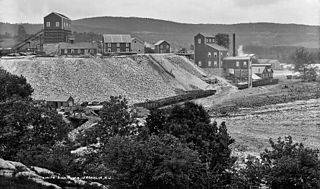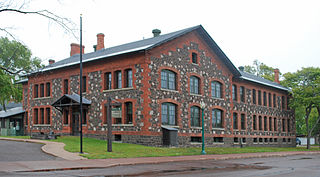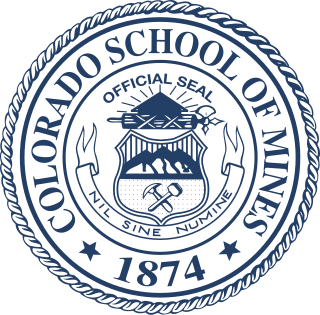Related Research Articles

Aurora is a town in Beaufort County, North Carolina, United States. The population was 455 at the 2020 census.

The Field Museum of Natural History (FMNH), also known as The Field Museum, is a natural history museum in Chicago, Illinois, and is one of the largest such museums in the world. The museum is popular for the size and quality of its educational and scientific programs, and its extensive scientific specimen and artifact collections. The permanent exhibitions, which attract up to 2 million visitors annually, include fossils, current cultures from around the world, and interactive programming demonstrating today's urgent conservation needs. The museum is named in honor of its first major benefactor, Marshall Field, the department-store magnate. The museum and its collections originated from the 1893 World's Columbian Exposition and the artifacts displayed at the fair.

Amateur geology or rock collecting is the non-professional study and hobby of collecting rocks and minerals or fossil specimens from the natural environment. In Australia, New Zealand and Cornwall, the amateur geologists call this activity fossicking. The first amateur geologists were prospectors looking for valuable minerals and gemstones for commercial purposes. Eventually, however, more people have been drawn to amateur geology for recreational purposes, mainly for the beauty that rocks and minerals provide.
The Meadowlands Museum is a museum located in Rutherford, New Jersey. It was established in 1961 as a repository for artifacts relating to the history of Rutherford and the New Jersey Meadowlands region.

Franklin Furnace, also known as the Franklin Mine, is a famous mineral location for rare zinc, iron, and manganese minerals in old mines in Franklin, Sussex County, New Jersey, United States. This locale produced more species of minerals and more different fluorescent minerals than any other location. The mineral association (assemblage) from Franklin includes willemite, zincite and franklinite.

Keweenaw National Historical Park is a unit of the U.S. National Park Service. Established in 1992, the park celebrates the life and history of the Keweenaw Peninsula in the Upper Peninsula of the U.S. state of Michigan. It is a federal-local cooperative park made up of two primary units, the Calumet Unit and the Quincy Unit, and almost two dozen cooperating "Heritage Sites" located on federal, state, and privately owned land in and around the Keweenaw Peninsula. The National Park Service owns approximately 1,700 acres (690 ha) in the Calumet and Quincy Units. Units are located in Baraga, Houghton, Keweenaw, and Ontonagon counties.

The New York State Museum is a research-backed institution in Albany, New York, United States. It is located on Madison Avenue, attached to the south side of the Empire State Plaza, facing onto the plaza and towards the New York State Capitol. The museum houses art, artifacts, and ecofacts that reflect New York’s cultural, natural, and geological development. Operated by the New York State Education Department's Office of Cultural Education, it is the oldest and largest state museum in the US. Formerly located in the State Education Building, the museum now occupies the first four floors of the Cultural Education Center, a ten-story, 1,500,000-square-foot (140,000 m2) building that also houses the New York State Archives and New York State Library.

Pala is a small, mostly Native American community and census-designated place located within the Pala Indian Reservation in San Diego County, California. For centuries a traditional gathering place of native peoples. The Mission San Antonio de Pala or Pala Mission was established in Pala by early 19th century as an asistencia or sub-mission.

The Lapworth Museum of Geology is a geological museum run by the University of Birmingham and located on the university's campus in Edgbaston, south Birmingham, England. The museum is named after the geologist Charles Lapworth, its origins dating back to 1880. It reopened in 2016 following a £2.7 million redevelopment project that created new galleries and displays, as well as modern visitor and educational facilities.

The National Mining Hall of Fame is a museum located in Leadville, Colorado, United States, dedicated to commemorating the work of miners and people who work with natural resources. The museum also participates in efforts to inform the public about the mining industry.

The New Jersey State Museum is located at 195-205 West State Street in Trenton, in the U.S. state of New Jersey. The museum's collections include natural history specimens, archaeological and ethnographic artifacts, and cultural history and fine art objects. Exhibitions, educational activities, research programs, and lectures are also offered. The museum, a division of the New Jersey Department of State, includes a 140-seat planetarium and a 384-seat auditorium.

The Rice Northwest Museum of Rocks and Minerals is a non-profit museum in Hillsboro, Oregon, United States. Located just north of the Sunset Highway on the northern edge of Hillsboro, the earth science museum is in the Portland metropolitan area. Opened in 1997, the museum's collections date to the 1930s with the museum housed in a home built to display the rock and mineral collections of the museum founders. The ranch-style home is listed on the National Register of Historic Places, the first of its kind listed in Oregon. In 2015 the museum became a Smithsonian Affiliate museum.

The Sterling Hill Mine, now known as the Sterling Hill Mining Museum, is a former zinc mine in Ogdensburg, Sussex County, New Jersey, United States. It was the last working underground mine in New Jersey. It closed in 1986, and became a museum in 1989. Along with the nearby Franklin Mine, it is known for its variety of minerals, especially the fluorescent varieties. It was added to the National Register of Historic Places in 1991.

The Mines Museum of Earth Science, formerly the Colorado School of Mines Geology Museum, is a geology museum located on the campus of the Colorado School of Mines, in Golden, Colorado, United States. It was established in 1877 by paleontologist and Mines' professor, Arthur Lakes. The first place to house the museum's collection was Jarvis Hall, which burnt down in 1878. While the museum awaited a new home, the collection continued to grow. Horace Patton was named Curator of the collection, still used primarily for teaching, in 1893. The collection was relocated to Guggenheim Hall in 1906, but upon Patton's retirement, the collection was relegated to storage. In 1940, upon completion of Berthoud Hall, home to Mines' geology department, the collection was unpacked by its newest Curator, J. Harlan Johnson and informally exhibited there until 2002.

Mineral collecting is the hobby of systematically collecting, identifying and displaying mineral specimens. Mineral collecting can also be a part of the profession of mineralogy and allied geologic specialties. Individual collectors often specialize in certain areas, for example collecting samples of several varieties of the mineral calcite from locations spread throughout a region or the world, or of minerals found in pegmatites.

The Arizona Mining and Mineral Museum in Phoenix, Arizona, was a museum focused on minerals and mining. Last operated by the Arizona Historical Society, a state government agency, its exhibits included more than 3,000 minerals, rocks, fossils, and artifacts related to the mining industry. The museum closed in May 2011. In April 2017, legislation was passed to reopen the museum under the ownership of the University of Arizona.

The James Mitchell Geology Museum is a geological museum based at the University of Galway in the West of Ireland. It is the only remnant of the university's defunct Natural History Museum. Regarded as "Galway's Hidden Museum", it is located in the university's Main Quad and cane be entered through a staircase in that structure's south-east corner.

The Museo di storia naturale della Maremma is a natural history museum in Grosseto, Tuscany, Italy.

Ganophyllite is a phyllosilicate mineral. It was named by Axel Hamberg in 1890 from the Greek words for leaf (φύλλον) and luster (γανωμα); the latter one was chosen due to the lustrous cleavages. The mineral was approved by the IMA in 1959, and it is a grandfathered mineral, meaning its name is still believed to refer to an existing species until this day. Tamaite is the calcium analogue, while eggletonite is the natrium analogue of said mineral.
Iron Hill Museum is a museum in Newark, Delaware, in the United States. Since 1968 it was located in a former African-American school, but moved to the new building in 2016.
References
- ↑ "Mindat.org entry for Franklin Mine". Mindat.org. Retrieved 19 May 2010.
- ↑ "About the Franklin Mineral Museum". Fortified Roofing. Retrieved 21 June 2017.